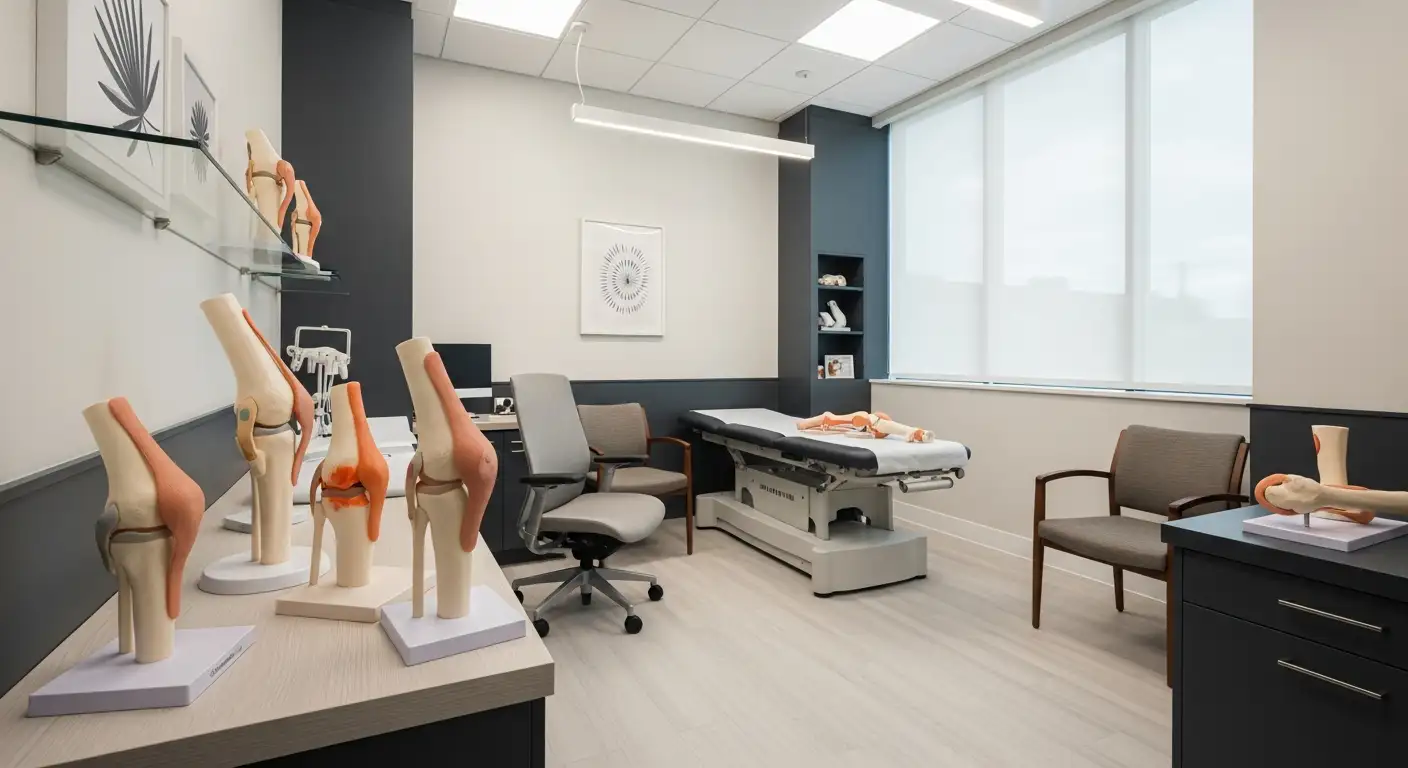Understanding Knee Pain from Overuse During Exercise
Knee pain resulting from overuse during exercise is a common complaint that affects people of all ages, from young athletes to older adults. It can stem from several causes including repetitive strain, muscle imbalances, poor technique, and underlying conditions such as osteoarthritis. Addressing and preventing knee pain requires a multifaceted approach that combines education, exercise modifications, appropriate medical treatments, and lifestyle changes to maintain knee health and function.
Common Causes and Signs of Knee Overuse Injuries

What causes knee pain from overuse during exercise?
Knee pain from overuse during exercise often results from repetitive stress impacting specific parts of the knee. This repeated strain can inflame or irritate tissues, leading to distinct conditions such as patellofemoral pain, which affects the area around the kneecap, and patellar tendonitis, characterized by irritation below the kneecap.
Overuse injury mechanisms
One common mechanism behind overuse knee injuries is muscle weakness, especially in the hip and thigh muscles, which increases load and strain on the knee joint. Tight muscles surrounding the knee also contribute by limiting flexibility and adding further stress to the joint structures during activity.
Symptoms of overuse knee pain
Symptoms typically include a gradual onset of pain, swelling, and tenderness localized over affected areas like the kneecap or tendon. Patients may also experience discomfort during or after exercise, reduced motion range, and sensations of clicking or catching in the joint.
Specific overuse conditions
- Patellofemoral pain syndrome: Pain around or behind the kneecap worsened by activities like running, squatting, or climbing stairs.
- Patellar tendonitis: Pain and tenderness below the kneecap often linked to jumping or repetitive knee extension.
- Iliotibial (IT) band syndrome: Pain on the outside of the knee caused by irritation of the IT band as it crosses the joint.
Understanding these overuse injury types and their typical symptoms is critical to managing knee pain effectively, often by modifying activity and strengthening surrounding muscles to reduce stress on the knee.
Role of Muscle Strength and Flexibility in Preventing Knee Overuse Pain

How does muscle strength and flexibility affect knee overuse pain?
Weakness in hip muscles, particularly the abductors, increases strain on the knee joint, thereby contributing to knee overuse pain. This added stress can lead to discomfort and potentially worsen existing knee conditions.
Tight muscles surrounding the knee, such as the quadriceps and hamstrings, also play a significant role. Muscle tightness reduces joint flexibility, limits motion, and can exacerbate pain, which collectively impair knee function.
Importance of hip and knee muscle strength
Strengthening exercises targeting the hip and knee muscles—especially the hip abductors and quadriceps—are crucial. These muscles provide essential support and stability to the knee joint, acting as a muscular scaffolding that helps absorb stress and protect the joint from overuse injuries.
Achievements in muscle strength improve the biomechanics of knee movement, distribute load more evenly, and thus help in preventing pain caused by chronic overuse.
Stretching exercises for knee health
Incorporating stretching into a knee health regimen enhances flexibility and reduces muscle tightness. Hamstring and quadriceps stretches are particularly beneficial.
Regular stretching increases the range of motion around the knee, eases tension in the muscles, and supports smoother, less painful joint motions. This can alleviate discomfort and reduce risk of injury during activities.
Effects of muscle tightness on knee pain
Muscle tightness around the knee restricts functional mobility and increases discomfort. It can create uneven forces across the joint, which may aggravate symptoms and worsen overuse injuries.
Addressing tightness with appropriate stretching complements strengthening efforts, producing a balanced approach toward knee health and pain prevention.
Overall, a combined approach of muscle strengthening and regular stretching is effective in mitigating knee overuse pain and improving joint function.
Exercise Types and Techniques to Protect Knees During Workouts

What types of exercise help prevent knee pain from overuse?
Effective exercise strategies for preventing knee pain from overuse focus on strengthening, aerobic activity, and stretching. Strengthening exercises such as side-leg raises and single-leg lifts target the muscles around the knee, providing crucial support and stability. Aerobic activities like cycling, swimming, and aquatic exercise offer excellent cardiovascular benefits while minimizing joint strain due to their low-impact nature.
Stretching exercises, including hamstring and quadriceps stretches, improve flexibility and reduce muscle tightness around the knee, which can otherwise exacerbate pain. These combined efforts build muscular scaffolding around the knee and pelvis, alleviating stress on the joint and potentially reducing symptoms of knee osteoarthritis or overuse injuries.
Importance of proper technique and gradual progression
Using proper technique is essential when performing knee-focused exercises. Careful attention to form helps prevent additional irritation or injury to the knee joint. Gradually increasing exercise intensity and duration allows the knee to adapt safely without sudden overload, significantly reducing aggravation risks.
If any exercise causes worsening knee pain, pain that persists beyond the activity, or pain that interferes with sleep, patients should pause exercise and seek medical advice. This cautious approach ensures long-term joint health and maximizes the benefits of physical activity.
Low-impact exercise alternatives
For individuals vulnerable to knee pain or with existing joint issues, low-impact exercises such as swimming, cycling, elliptical workouts, and aquatic exercise provide excellent alternatives to high-impact activities like running. These exercises reduce repetitive stress on the knee joint while still promoting cardiovascular fitness and muscle strength.
In summary, a balanced exercise program that includes strengthening, aerobic, and stretching activities—performed with proper technique and gradual progression—can effectively prevent knee pain from overuse. Choosing low-impact options further protects the knee joint, making this approach suitable for a wide range of individuals aiming to maintain healthy knees during workouts.
Modifying Exercise to Reduce Knee Joint Stress

How can exercise be modified to prevent knee pain?
Modifying exercise to protect the knee joint involves reducing activities that place excessive stress on the joint. High-impact exercises such as running or jumping can exacerbate knee pain and potentially worsen osteoarthritis symptoms. Instead, patients are encouraged to engage in non-impact activities which minimize joint loading.
Activity Modification Strategies
- Reducing Impact: Avoid running, high-intensity jumping, or repetitive heavy load activities.
- Adjusting Movements: Modify movement patterns that provoke pain, such as deep knee bends or twisting.
- Pacing: Gradually increase exercise intensity and duration to avoid aggravating symptoms.
Benefits of Non-Impact Activities
Non-impact exercises are effective alternatives that help maintain fitness while reducing knee joint stress:
- Swimming and Aquatic Exercise: Water resistance supports muscles without weight-bearing stress, leading to pain relief and improved function.
- Cycling: Stationary or outdoor cycling allows aerobic conditioning without impact, enhancing joint movement and muscle strength.
- Elliptical Trainers and Rowing: These machines provide smooth movement patterns that limit joint strain.
Importance of Listening to Pain Signals
Patients should closely monitor their symptoms during exercise. Pain that worsens with activity, persists at rest, or awakens a person at night signals the need to stop exercising and consult a healthcare provider. Proper technique and gradual progression prevent further injury.
In summary, modifying exercise by focusing on low-impact activities and respecting pain signals helps prevent knee joint overload, improving long-term knee health and function.
Importance of Patient Education and Self-Management in Knee Pain Prevention

What role does patient education play in preventing knee pain from overuse?
Patient education is crucial in preventing knee pain caused by overuse. Education programs empower patients with essential knowledge about knee anatomy and the mechanics behind safe movement and exercise. Understanding these factors helps individuals adopt proper techniques that reduce strain on the knee and protect the joint from injury.
In addition to fostering awareness of anatomy and biomechanics, education helps patients recognize early signs of knee problems such as pain, swelling, or clicking sensations. This recognition encourages early intervention and modification of activities to prevent further damage.
Educating patients about knee health
A comprehensive patient education approach includes teaching about:
- The structure and function of the knee joint
- Common causes of knee pain, including overuse and osteoarthritis
- Safe exercise practices, including the importance of strengthening and stretching muscles around the knee and hip
- Weight management benefits for protecting knee health
Self-management strategies
Self-management plays a significant role in maintaining knee health by enabling patients to take an active role in their care. Strategies include:
- Gradually increasing physical activity intensity to avoid overloading the joint
- Incorporating strengthening exercises like side-leg raises and single-leg lifts to build supportive muscle scaffolding
- Using low-impact exercises such as cycling, swimming, or aquatic therapy to reduce joint stress
- Monitoring symptoms closely and seeking timely medical advice when pain worsens or unusual signs appear
Addressing misconceptions about knee pain
Education programs also focus on correcting common misconceptions, such as the belief that all knee pain requires rest or surgery. Instead, patients learn that consistent, appropriate exercise and weight control can reduce pain and improve function. This understanding motivates adherence to long-term self-management and prevents unnecessary inactivity that can worsen joint stiffness and muscle weakness.
Weight Management as a Key Factor in Knee Pain Prevention
How does weight management affect knee pain and osteoarthritis?
Excess body weight places significantly increased stress on the knee joints. Research shows that for every pound of body weight lost, the knee experiences approximately four pounds less load. This means that even a modest weight reduction can substantially decrease joint stress, helping to alleviate knee pain.
Impact of excess weight on knee load
Carrying extra weight accelerates the deterioration of cartilage within the knee. The added pressure intensifies the wear and tear characteristic of osteoarthritis, leading to increased pain and reduced function. Overweight and obese individuals often report worsened symptoms due to this biomechanical strain.
Benefits of weight loss on pain and function
Losing at least 5% of body weight has been demonstrated to significantly reduce pain, stiffness, and difficulty in moving the knee. Larger weight losses, such as 10%, are associated with meaningful improvements not only in pain relief but also in overall quality of life and joint function.
Combining diet and exercise
Weight management strategies that incorporate both dietary modifications and physical activity offer superior results compared to either method alone. This combined approach promotes greater weight loss and produces better outcomes in managing knee osteoarthritis symptoms.
By incorporating weight loss through diet and exercise, patients with knee issues can substantially reduce joint stress, ease pain, and improve mobility, making it a cornerstone in the prevention and management of knee osteoarthritis.
Use of Braces and Supports to Prevent and Manage Knee Pain
Types of Knee Braces
Knee braces come in various designs targeting different needs. Common types include:
- Unloader braces that reduce pressure on the affected knee compartment.
- Supportive sleeves that provide compression and warmth.
- Hinged braces offering enhanced stability for ligament support.
Each type aims to improve joint alignment, reduce pain, and enhance function.
Evidence Supporting Brace Use
Randomized controlled trials provide solid evidence that braces improve pain, function, and quality of life in patients with knee osteoarthritis. The braces provide mechanical support and stability, which can be especially beneficial for managing knee pain caused by overuse or degenerative changes.
Roles of Canes and Orthoses
Canes are recommended as adjunct supports to reduce load and improve balance. Moderate-quality studies support the use of canes for pain relief and functional enhancement, especially during flare-ups or when stability is compromised.
While some orthoses like hand orthoses may aid other joints, lateral wedge insoles and modified shoes lack reliable evidence for efficacy in knee osteoarthritis and are generally not recommended.
Are braces and supports effective for managing knee pain from overuse?
Knee braces have been shown in randomized controlled trials to improve pain, function, and quality of life in knee osteoarthritis patients, providing support and stability. Canes also improve pain and function, supported by moderate-quality evidence, especially useful during flare-ups or for balance support.
Pharmacological Interventions for Managing Knee Pain During Exercise
Role of Oral and Topical NSAIDs
Non-steroidal anti-inflammatory drugs (NSAIDs) play a significant role in managing knee pain associated with overuse, especially in conditions like knee osteoarthritis. Both oral and topical NSAIDs have been shown through high-quality studies to provide effective short-term relief of pain and improve function. They are a common choice for patients needing symptom management during physical activities.
Use of Acetaminophen
Acetaminophen is another pharmacologic option recommended for knee pain relief. While evidence supports its effectiveness, NSAIDs are generally found to be more effective in reducing pain and improving joint function. Acetaminophen can be considered especially for those who may not tolerate NSAIDs well.
Limitations and Precautions
Despite their benefits, NSAIDs and acetaminophen come with important limitations. NSAIDs should be used at the lowest effective dose and for the shortest duration possible to reduce risks of side effects, including gastrointestinal issues and cardiovascular concerns. Patients are advised to consult healthcare providers to tailor medication use safely.
| Medication Type | Effectiveness | Precautions and Limitations |
|---|---|---|
| Oral NSAIDs | Strong evidence for pain relief | Risk of GI and CV side effects; use shortest duration |
| Topical NSAIDs | Effective for pain and function | Fewer systemic effects; limited to local application |
| Acetaminophen | Recommended for pain relief | Less effective than NSAIDs; liver toxicity at high doses |
Using these medications judiciously can help patients manage knee pain from overuse and maintain exercise routines safely and effectively.
Limitations and Risks of Common Knee Pain Treatments
What treatments are not recommended or carry risks for knee pain?
Certain treatments for knee pain and osteoarthritis come with significant limitations or risks that patients and clinicians should be aware of.
Oral Narcotics: These are strongly discouraged due to their ineffectiveness in managing knee pain and the high risk of dependency and other adverse effects. Safer and more effective alternatives are generally preferred.
Supplements: Common oral and dietary supplements such as glucosamine, chondroitin, turmeric, and ginger extract have inconsistent and limited evidence supporting their benefits for pain relief and functional improvement. While some patients use them, caution is advised due to the variability in outcomes and lack of strong clinical support.
Non-Recommended Interventions: Several therapies lack reliable evidence or are associated with limited benefits. For instance, lateral wedge insoles are not recommended because studies do not show significant pain or functional improvements. Manual therapies, while sometimes used alongside exercise, have limited and inconsistent backing. Hyaluronic acid injections are generally not advised, especially for hip osteoarthritis, due to low clinical significance of benefits and varied guideline recommendations. Knee arthroscopy, including procedures like lavage and debridement, is also not supported by evidence for routine use.
Patients should engage in treatments with proven benefits, such as exercise therapy, education, and weight management, and avoid interventions with unclear efficacy or heightened risks. Healthcare providers play a critical role in guiding patients toward safe and effective management strategies for knee pain.
Physical Therapy and Neuromuscular Training for Knee Pain Prevention
How do physical therapy and neuromuscular training help knee pain?
Physical therapy, particularly supervised exercise programs, offers significant benefits in reducing knee pain and improving function for patients with knee osteoarthritis. High-quality evidence from multiple randomized controlled trials supports the use of structured exercise therapy as a core treatment, demonstrating consistent improvements in symptom relief and quality of life.
Benefits of supervised exercise
Supervised exercise includes strengthening, stretching, and aerobic activities tailored to individual needs. These programs not only enhance muscle support around the knee and hip but also improve joint flexibility and overall fitness. Regular participation leads to better pain control and functional capacity, with benefits comparable to analgesic medications but without the associated risks.
Combining neuromuscular training with traditional exercise
Neuromuscular training focuses on retraining movement patterns, enhancing balance, coordination, and muscle activation. When combined with traditional strengthening and aerobic exercises, it can further improve gait, reduce abnormal load on the knee joint, and boost performance-based function such as walking speed. Moderate-quality evidence indicates that this combination provides superior outcomes compared to exercise alone.
Improving gait and load distribution
Correcting gait abnormalities and optimizing load distribution through targeted neuromuscular exercises help alleviate stress on the knee joint. This approach reduces pain and functional limitations often seen in knee osteoarthritis by promoting proper knee alignment and movement control during activities such as walking.
In summary, integrating supervised physical therapy with neuromuscular training delivers a comprehensive strategy to manage knee pain effectively, improve mobility, and enhance patients' quality of life.
Complementary Therapies: Massage, Acupuncture, and Electrotherapy
What is the role of complementary therapies for knee pain from overuse?
Complementary therapies such as massage, acupuncture, and electrotherapy are often considered to help manage knee pain from overuse, but their effectiveness varies.
Massage may provide temporary relief for pain and improve function in knee osteoarthritis. However, the evidence supporting massage is limited and inconsistent, so any benefits are often short-lived and not reliably sustained.
Acupuncture has shown some potential to modestly improve pain and function in patients with knee osteoarthritis. Despite these positive effects, the overall quality of evidence is limited and downgraded due to inconsistent findings across studies. Therefore, acupuncture should be viewed as a supplementary option rather than a primary treatment.
Electrotherapeutic methods, including transcutaneous electrical nerve stimulation (TENS) and extracorporeal shockwave therapy, present mixed evidence. Some studies suggest possible benefits in reducing pain and improving function, but inconsistent results have led to a cautious approach regarding their recommendation. These therapies might be considered when other treatments have not yielded sufficient relief.
In summary, while complementary therapies can be part of a multifaceted approach to managing knee pain from overuse, they should be applied with realistic expectations and alongside established treatments like exercise and patient education.
Emerging and Minimally Invasive Treatments for Knee Osteoarthritis
Are there new treatments for knee osteoarthritis that show promise?
Yes, several emerging and minimally invasive treatment options for knee osteoarthritis (OA) have gained attention due to their potential benefits in reducing pain and improving function with less invasive approaches than traditional surgery.
What is genicular artery embolization (GAE)?
Genicular artery embolization is a novel procedure that targets abnormal blood vessels in the knee linked to inflammation and pain in OA. By selectively blocking these vessels, GAE aims to reduce inflammation and decrease pain levels. Clinical reports indicate promising outcomes, with many patients experiencing significant pain relief that can last for at least one year following the procedure. This minimally invasive approach is performed via catheterization and may offer a viable option for patients who are not candidates for or want to delay joint replacement surgery.
What is the MISHA Knee System implant?
The MISHA Knee System is an FDA-approved implant designed to offload stress from the damaged compartments of the knee joint. Unlike traditional joint replacement, this implant is less invasive and focuses on preserving the native joint structure while improving mechanical loading and function. Patients receiving the MISHA implant often report improved knee function and reduced pain, with the benefit of a shorter recovery time compared to conventional knee arthroplasty.
What is the current evidence and future outlook for these treatments?
While both genicular artery embolization and the MISHA Knee System show promise as innovative alternatives for managing knee OA, the current evidence base is still evolving. Short- to medium-term results suggest effectiveness in pain reduction and functional improvement. However, larger-scale studies and longer-term data are needed to fully establish safety profiles, durability of benefits, and comparative effectiveness against standard treatments.
With ongoing research, these emerging therapies may soon become valuable additions to the knee OA treatment arsenal, providing patients with more personalized and less invasive options to manage symptoms and improve quality of life.
When Should Surgery Be Considered for Knee Overuse Pain and Osteoarthritis?
When Is Surgery Recommended for Patients with Knee Osteoarthritis?
Surgery is primarily considered for individuals suffering from knee osteoarthritis who experience severe and persistent symptoms that have not improved despite comprehensive conservative treatments such as exercise, weight management, and pharmacologic therapies. Key indicators include significant pain that limits daily activities and notably impaired joint function.
Radiographic imaging supporting advanced joint damage, such as cartilage loss or bone deformities, helps guide the decision towards surgical options.
Types of Surgical Procedures
Several surgical interventions may be appropriate depending on disease severity and patient-specific considerations. These include:
- High Tibial Osteotomy: A realignment surgery intended to relieve pressure on the damaged part of the knee, suitable for younger, active patients with unicompartmental osteoarthritis. Evidence is limited but suggests possible pain and function improvement.
- Partial Meniscectomy: Removal of injured meniscal tissue in certain cases of meniscal tears, which may alleviate symptoms; moderate evidence supports its use in select cases.
- Total or Partial Knee Replacement (Arthroplasty): Recommended for advanced joint damage unresponsive to other treatments, improving pain, function, and quality of life.
Decision-Making Considerations
Choosing surgery involves evaluating patient factors such as age, activity level, comorbidities, and personal preferences. It's crucial to exhaust non-surgical treatments including exercise, education, weight loss, and medication before proceeding.
Referral to orthopedic specialists should be considered when conservative management fails, and when radiographic and clinical assessments confirm indications.
Patient education on realistic outcomes and potential risks of surgery is essential to informed decision-making.
The Crucial Role of Exercise Types in Managing Knee Osteoarthritis Symptoms
What types of exercise are most beneficial for knee osteoarthritis?
Aerobic exercises like walking and cycling are fundamental in managing knee osteoarthritis (KOA). These activities help reduce pain and enhance physical function by increasing cardiovascular fitness and joint mobility. Resistance training, or strength training, plays a vital role by reinforcing the muscles around the knee, which in turn decreases stress on the joint and supports better stability.
Aerobic Exercise Benefits
Aerobic exercise is linked to improvements in reducing knee pain and stiffness. For example, stationary cycling has been shown to effectively improve pain scores and walking endurance (like the 6-minute walk test), making it excellent for sustaining daily function.
Strength Training Importance
Targeted strengthening exercises, such as side-leg raises and single-leg lifts, build muscle scaffolding around the knee and pelvis. Stronger hip and thigh muscles alleviate abnormal strain on the knee, contributing to symptom relief and enhanced joint support.
Effectiveness of Yoga and Aquatic Exercise
Yoga stands out for its ability to improve joint stiffness and overall knee function by incorporating stretching and strengthening in a low-impact manner. Aquatic exercise offers unique benefits by reducing weight-bearing on the joint through buoyancy, providing significant pain relief and allowing patients to perform movements with less discomfort.
In summary, a combination of aerobic activity, strength training, yoga, and aquatic exercises offers a comprehensive approach to alleviate pain, improve stiffness, and restore function in knee osteoarthritis. Tailoring these exercises to individual needs and maintaining regular participation are essential for optimal outcomes.
Supervision and Personalization of Exercise Programs
Why is supervision and personalization important in exercise therapy for knee pain?
Supervised exercise sessions significantly enhance the benefits of exercise therapy for knee osteoarthritis by ensuring patients perform movements with proper technique and at an appropriate intensity. This supervision reduces the risk of injury and maximizes the effectiveness of the training.
Personalizing exercise programs to meet individual patient needs—including specific symptoms, functional limitations, and preferences—helps optimize treatment outcomes. Tailored programs can address particular areas such as pain, stiffness, or muscle weakness and accommodate factors like pain tolerance or comorbidities.
Ongoing participation in exercise is critical for maintaining improvements in pain and function. To support long-term adherence, education about the importance of consistent physical activity and periodic booster sessions can be provided. These resources help reinforce motivation and address challenges in continuing the program over time.
Ultimately, a combination of supervised sessions, personalized exercise plans, and sustained engagement supported by education ensures better management of knee osteoarthritis symptoms and improved quality of life.
Weight Loss Strategies and their Impact on Knee Joint Load and Pain
What are effective weight loss strategies to reduce knee pain?
Effective weight loss strategies for reducing knee pain focus primarily on behavioral modifications. These include dietary changes aimed at reducing caloric intake and increasing physical activity to promote energy expenditure. Combining both diet and exercise produces the best outcomes for weight reduction and symptom improvement in knee osteoarthritis.
Behavioral Modifications
Behavioral approaches involve educating patients to adopt healthier eating habits along with increasing movement throughout daily life. This integrated lifestyle change not only helps reduce body weight but also positively affects joint pain and function by lessening mechanical stress on the knees.
Combining Diet and Exercise
Studies support that combining diet and exercise interventions leads to greater weight loss and better osteoarthritis outcomes compared to either approach alone. Exercise types beneficial for osteoarthritis include aerobic activities like walking, swimming, and resistance training, which also improve joint strength and mobility.
Medical and Surgical Interventions
For individuals with severe obesity or those who do not respond to lifestyle changes alone, adjunct options may be considered. These include:
- Medications: Prescription weight-loss drugs can assist with weight reduction but should be used under medical supervision.
- Bariatric surgery: In severe cases, surgical interventions can lead to significant weight loss, dramatically decreasing knee joint load and improving pain and function.
Impact on Knee Joint Load and Pain
Each pound of weight lost reduces the load on the knee joint by approximately four pounds. A minimum of 5% weight loss is linked to significant reductions in pain, stiffness, and disability. Larger weight reductions, such as 10%, contribute to meaningful improvements in quality of life and physical function.
By adopting these strategies, patients with knee osteoarthritis can achieve dual benefits: decreased joint stress leading to pain relief and enhanced mobility, and improved overall health through weight management.
Integration of Patient Self-Management Programs for Long-Term Knee Pain Control
How do self-management programs assist in preventing and managing knee pain?
Self-management programs are designed to empower patients with knee osteoarthritis by providing education about the condition and practical skills for managing symptoms. These programs typically include components such as understanding the disease process, recognizing symptom changes, pacing daily activities to minimize strain, and learning safe exercise techniques that strengthen muscles around the knee.
Research has shown that self-management programs significantly improve pain levels and joint function in individuals with knee osteoarthritis. The high-quality evidence supporting these effects makes them a fundamental part of comprehensive knee pain management.
Components of self-management
- Patient education: Providing detailed knowledge about osteoarthritis, its progression, and symptom management.
- Symptom monitoring: Teaching patients to detect changes in pain or function, allowing timely adjustments.
- Activity pacing: Advising on how to balance activity and rest to avoid flare-ups.
- Exercise guidance: Incorporating personalized, safe exercises such as strengthening and stretching to support joint health.
Improving pain and function
Participants in self-management programs often experience reduced pain and improved joint mobility. These improvements result from better understanding and management of their condition, enabling more consistent physical activity and avoidance of harmful habits.
Supporting adherence through community programs
Sustained benefits require long-term participation. Community-based programs and healthcare interventions provide necessary support by creating accessible platforms for ongoing physical activity and education. Clinicians also play a crucial role by motivating patients, addressing barriers, and facilitating referrals to appropriate resources.
Through this integrated approach, self-management programs help individuals maintain or improve their quality of life despite chronic knee pain.
Recognizing When to Seek Medical Advice for Knee Pain During Exercise
When should patients stop exercising and seek medical advice for knee pain?
Patients should immediately stop exercise and seek medical consultation if they experience warning signs such as fever, worsening pain especially at night or that increases with activity, swelling, or locking of the knee joint. These symptoms indicate potential injury or worsening joint conditions requiring prompt assessment.
Warning signs to watch for
- Fever accompanying knee pain
- Increasing pain during or after exercise
- Night-time pain waking the patient
- Swelling or visible inflammation around the knee
- Sensations of joint locking or catching
Importance of early intervention
Early medical evaluation helps prevent the progression of knee injuries and underlying conditions such as osteoarthritis. Timely treatment can reduce pain, improve function, and avoid complications that may require more intensive therapies or surgery.
Symptoms indicating severity
Persistent or worsening symptoms during physical activity, instability of the knee, and systemic signs like fever suggest a more severe condition. Patients experiencing these signs should not delay medical assessment to ensure appropriate management and to safeguard joint health.
Lifestyle and Behavioral Modifications to Support Knee Health
What lifestyle changes help prevent knee pain from overuse?
Avoiding repetitive high-impact activities is essential in preventing knee pain caused by overuse. Activities that repeatedly stress the knee joint can accelerate cartilage wear and lead to inflammation or injury. Instead, incorporating regular low-impact movements such as swimming, cycling, elliptical workouts, and rowing provides cardiovascular benefits without excessive joint strain. These exercises maintain muscle strength around the knee and improve flexibility, reducing the risk of pain and injury.
Maintaining overall cardiovascular health through consistent moderate aerobic activity supports joint health by improving blood flow and reducing systemic inflammation linked to osteoarthritis progression. Engaging in at least 150 minutes of moderate-intensity activity per week, complemented by strengthening exercises targeting muscles that stabilize the knee and hip, helps to reduce knee load and improve function. This balanced approach not only prevents degeneration but also aids in managing existing symptoms effectively.
In summary, lifestyle modifications focused on reducing high-impact repetitive stress and promoting cardiovascular fitness through low-impact, regular physical activity are crucial strategies for preventing knee pain from overuse and preserving long-term knee health.
Addressing Muscle Imbalance and Alignment Issues to Minimize Knee Pain
How do muscle imbalances and alignment affect knee pain?
Muscle imbalances, including weak hip abductors and tight iliotibial (IT) band, can change the way forces act on the knee joint. This altered mechanics increase stress on specific parts of the knee, which contributes to pain and the progression of osteoarthritis. For example, weak muscles around the hip fail to stabilize the pelvis and knee properly, leading to abnormal knee movement and strain.
Benefits of hip and thigh muscle strengthening
Strengthening the hip and thigh muscles provides better support and stabilization for the knee. Exercises focusing on side-leg raises, single-leg lifts, and targeted resistance training can build muscle scaffolding around the knee and pelvis. Stronger muscles reduce load on the joint and improve functional ability, helping to alleviate pain and stiffness associated with knee osteoarthritis.
Neuromuscular control exercises and correcting movement patterns
Neuromuscular training aims to improve muscle coordination, balance, and control during movement. Incorporating neuromuscular exercises with traditional strengthening routines enhances gait and walking speed by improving how muscles fire and support the knee joint during activity. This training can help correct faulty movement patterns and ensure loads are better distributed across the knee, which reduces overuse injuries and discomfort.
Overall, addressing muscle imbalances and alignment through a combination of strengthening and neuromuscular exercises is a proven, effective approach to minimize knee pain and improve function.
Use of Injections and Minimally Invasive Procedures in Managing Knee Overuse Pain
What is the role of injections in treating knee pain?
Injections play a supportive role in managing knee overuse pain, particularly in osteoarthritis cases. Intra-articular corticosteroid injections are commonly used to provide short-term relief by reducing inflammation within the joint. They can ease pain and improve function temporarily but require cautious use due to potential side effects and risks with repeated administration.
Another option, platelet-rich plasma (PRP) injections, involve concentrating platelets from the patient's own blood to reduce inflammation and promote healing. PRP may improve pain and function and is considered to have fewer systemic side effects compared to corticosteroids. However, current evidence remains limited and heterogeneous, meaning its effectiveness is not fully confirmed.
What are the limitations and risks associated with these injections?
While corticosteroid injections can rapidly decrease symptoms, their benefits are short-lived and frequent use may harm joint structures. PRP injections, though promising, lack strong uniform evidence and remain an emerging therapy. Neither injection type reverses joint degeneration or serves as a standalone cure. They are best viewed as adjuncts to comprehensive treatment plans that include exercise and weight management.
Patients considering these treatments should discuss potential benefits and risks with their healthcare providers. Decisions should factor in symptom severity, overall health status, and treatment goals.
| Injection Type | Benefits | Limitations and Risks |
|---|---|---|
| Intra-articular corticosteroids | Short-term pain relief; reduces inflammation | Temporary effect; potential joint damage with repeated use |
| Platelet-rich plasma (PRP) | May reduce pain; fewer systemic side effects | Limited and inconsistent evidence; not a cure |
In summary, injections can help manage symptoms of knee overuse pain but should be integrated cautiously within broader therapeutic strategies rather than relied on exclusively.
Summary and Key Recommendations for Preventing Knee Pain from Exercise Overuse
Preventing knee pain caused by overuse during exercise requires a balanced approach emphasizing education, proper exercise techniques, muscle strengthening, flexibility, and appropriate lifestyle modifications including weight management. First-line strategies focus on strengthening and stretching exercises that support the knee joint, modifying activities to reduce impact, and utilizing supervised physical therapy to optimize outcomes. Pharmacological options like NSAIDs and topical treatments provide symptomatic relief, while supportive devices such as braces and canes can enhance function when needed. Emerging minimally invasive treatments show promise but require further study. When conservative methods fail and symptoms severely impact quality of life, surgical interventions may be considered. Patients should remain vigilant for worsening symptoms and seek timely medical advice. Overall, combining knowledge, prevention, and evidence-based treatment offers the best defense against knee pain from exercise overuse, supporting sustained joint health and active lifestyles.
References
- Management of Osteoarthritis of the Knee (Non-Arthroplasty)
- Osteoarthritis Management: Updated Guidelines from the ...
- Take control of your knee pain
- Recommendations for the management of hip and knee ...
- The Critical Role of Physical Activity and Weight ...
- Knee Health: Tips to Reduce Pain
- Exercise Therapy for Knee Osteoarthritis: A Systematic ...
- Physical Activity and Exercise Therapy Benefit More Than ...





